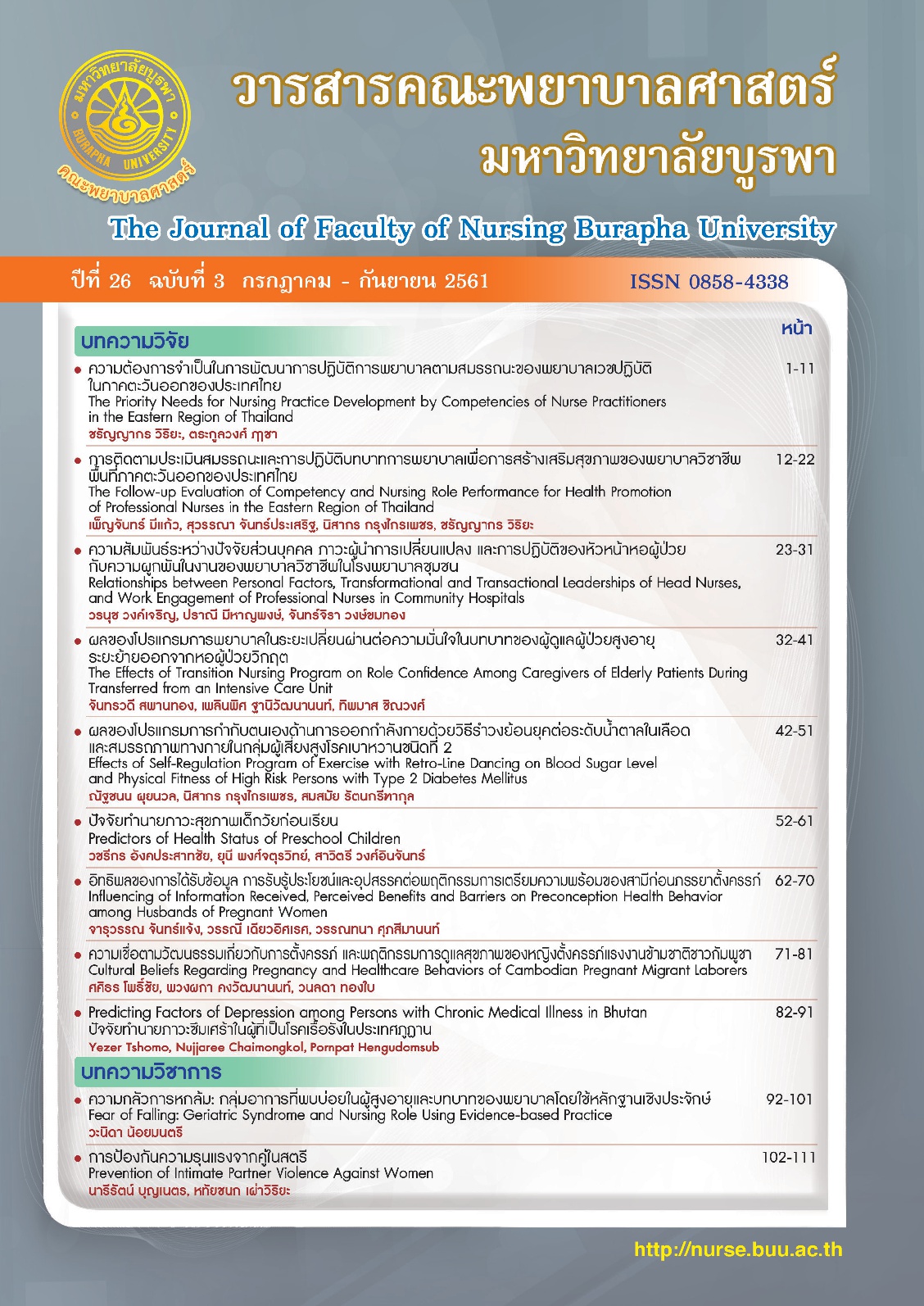ปัจจัยทำนายภาวะซึมเศร้าในผู้ที่เป็นโรคเรื้อรังในประเทศภูฏาน
คำสำคัญ:
ภาวะซึมเศร้า, โรคเรื้อรัง, การสนับสนุนทางสังคม, กิจกรรมทางกาย, ประเทศภูฏานบทคัดย่อ
บทคัดย่อ
การวิจัยแบบทำนายครั้งนี้มีวัตถุประสงค์เพื่อศึกษาปัจจัยทำนายภาวะซึมเศร้า ได้แก่ อายุ เพศ รายได้ ระยะเวลาการป่วย จำนวนโรคเรื้อรัง กิจกรรมทางกาย และการสนับสนุนทางสังคม ในผู้ที่เป็นโรคเรื้อรังในประเทศภูฏาน กลุ่มตัวอย่างจำนวน 120 คนคัดเลือกโดยวิธีการสุ่มอย่างง่ายคือ ผู้ใหญ่ที่ได้รับการวินิจฉัยด้วยโรคเรื้อรัง และมารับการรักษาต่อเนื่องในโรงพยาบาล ประเทศภูฏาน เก็บรวบรวมข้อมูลระหว่างเดือนมีนาคมถึงเดือนเมษายน พ.ศ. 2561 เครื่องมือวิจัยประกอบด้วยแบบสอบถามที่ให้กลุ่มตัวอย่างเป็นผู้ตอบเอง ได้แก่ แบบสอบถามข้อมูลทั่วไป ภาวะสุขภาพของผู้ป่วย กิจกรรมทางกายทั่วไป และการสนับสนุนทางสังคม มีค่าความเชื่อมั่นอยู่ระหว่าง .88-.93 วิเคราะห์ข้อมูลด้วยสถิติพรรณนา และการวิเคราะห์ถดถอยพหุคูณแบบขั้นตอน
ผลการวิจัยพบว่ามี 5 ปัจจัยที่สามารถทำนายภาวะซึมเศร้าได้อย่างมีนัยสำคัญทางสถิติ โดยทำนายได้ร้อยละ 35.5 ปัจจัยทำนายที่ดีที่สุดคือเพศ (ชาย) (β = -.242) รองลงมาคืออายุ (β = -.218) กิจกรรมทางกาย (β = -.229) การสนับสนุนทางสังคม (β = -.202) และระยะเวลาที่ป่วย (β = -.168) ผลการวิจัยนี้ให้ข้อเสนอแนะว่า พยาบาลและผู้ที่เกี่ยวข้องในการดูแลสุขภาพสามารถนำไปใช้ประโยชน์ในการวางแผนและพัฒนากิจกรรมหรือโครงการส่งเสริมการสนับสนุนทางสังคมและกิจกรรมทางกาย เพื่อช่วยลดภาวะซึมเศร้าในผู้ที่เป็นโรคเรื้อรัง โดยเน้นในกลุ่มเพศหญิง อายุน้อย และผู้ป่วยรายใหม่
เอกสารอ้างอิง
Bishwajit, G., O’Leary, D. P., Ghosh, S., Yaya, S., Shangfeng, T., & Feng, Z. (2017). Physical inactivity and self-reported depression among middle-and older-aged population in South Asia: World health survey. BMC geriatrics, 17(1), 100.
Boing, A. F., Melo, G. R., Boing, A. C., Moretti-Pires, R. O., Peres, K. G., & Peres, M. A. (2012). Association between depression and chronic diseases: results from a population-based study. Revista de saude publica, 46(4), 617-623.
Dhillon, P. K., Jeemon, P., Arora, N. K., Mathur, P., Maskey, M., Sukirna, R. D., & Prabhakaran, D. (2012). Status of epidemiology in the WHO South-East Asia region: burden of disease, determinants of health and epidemiological research, workforce and training capacity. International journal of epidemiology, 41(3), 847-860.
Dorji, G., Choki, S., Jamphel, K., Wangdi, Y., Chogyel, T., Dorji, C., & Nirola, D. K. (2017). Policy and governance to address depression and suicide in Bhutan: The national suicide-prevention strategy. WHO South-East Asia Journal of Public Health, 6(1), 39.
Goldberg, D. (2010). The detection and treatment of depression in the physically ill. World Psychiatry, 9(1), 16-20.
Gottlieb, S. S., Khatta, M., Friedmann, E., Einbinder, L., Katzen, S., Baker, B., . . . Fisher, M. L. (2004). The influence of age, gender, and race on the prevalence of depression in heart failure patients. Journal of the American College of Cardiology, 43(9), 1542-1549.
Grav, S., Hellzèn, O., Romild, U., & Stordal, E. (2012). Association between social support and depression in the general population: the HUNT study, a cross‐sectional survey. Journal of clinical nursing, 21(1‐2), 111-120.
Gunn, J. M., Ayton, D. R., Densley, K., Pallant, J. F., Chondros, P., Herrman, H. E., & Dowrick, C. F. (2012). The association between chronic illness, multimorbidity and depressive symptoms in an Australian primary care cohort. Social psychiatry and psychiatric epidemiology, 47(2), 175-184.
Hare, D. L., Toukhsati, S. R., Johansson, P., & Jaarsma, T. (2013). Depression and cardiovascular disease: a clinical review. European heart journal, 35(21), 1365-1372.
Kaewmart, N., Koedbangkham, J., & Nabkasorn, C. (2011). Factors influencing Depression among nursing students of Burapha University. Journal of Faculty of Nursing, Burapha university,19(Suppl 2), 83-95.
Katon, W. J. (2011). Epidemiology and treatment of depression in patients with chronic medical illness. Dialogues in clinical neuroscience, 13(1), 7.
Khuwaja, A. K., Lalani, S., Dhanani, R., Azam, I. S., Rafique, G., & White, F. (2010). Anxiety and depression among outpatients with type 2 diabetes: A multi-centre study of prevalence and associated factors. Diabetology & metabolic syndrome, 2(1), 72.
Nan, H., Lee, P. H., McDowell, I., Ni, M. Y., Stewart, S. M., & Lam, T. H. (2012). Depressive symptoms in people with chronic physical conditions: prevalence and risk factors in a Hong Kong community sample. BMC psychiatry, 12(1), 198.
Neupane, D., Panthi, B., McLachlan, C. S., Mishra, S. R., Kohrt, B. A., & Kallestrup, P. (2015). Prevalence of undiagnosed depression among persons with hypertension and associated risk factors: a cross-sectional study in urban Nepal. PloS one, 10(2), e0117329.
Pelzang, R. (2012). The pattern of psychiatric admissions in a referral hospital, Bhutan. WHO South-East Asia Journal of Public Health, 1(1), 52.
Spearing, R., & Bailey, J. (2012). Depression and chronic physical illness: its prevalence and diagnosis, and implications for therapeutic practice. International Journal of Therapy & Rehabilitation, 19(7).
Tsai, T.-Y., Livneh, H., Lu, M.-C., Tsai, P.-Y., Chen, P.-C., & Sung, F.-C. (2013). Increased risk and related factors of depression among patients with COPD: a population-based cohort study. BMC public health, 13(1), 976.
Turner, J., & Kelly, B. (2000). Emotional dimensions of chronic disease. Western journal of medicine, 172(2), 124.
Wang, X., Cai, L., Qian, J., & Peng, J. (2014). Social support moderates stress effects on depression. International journal of mental health systems, 8(1), 41.
Weaver, L. J., & Hadley, C. (2011). Social pathways in the comorbidity between type 2 diabetes and mental health concerns in a pilot study of urban middle‐and upper‐class Indian women. Ethos, 39(2), 211-225.





